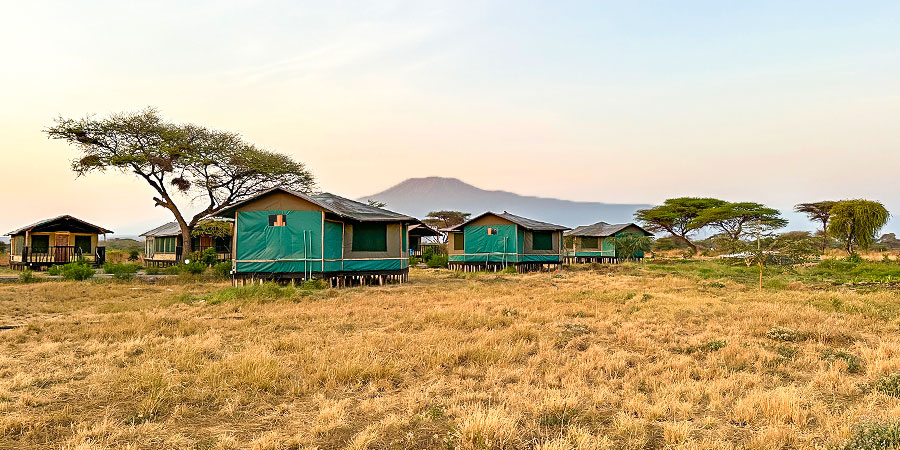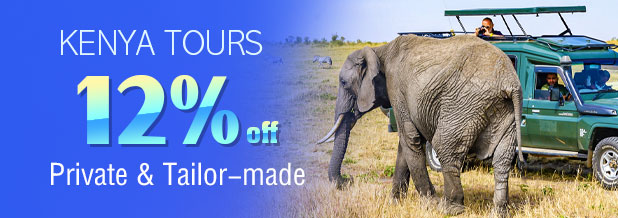Kenya Weather
- Climatic Zones: Tropical Savanna Climate, Tropical Desert Climate, Tropical Plateau Climate
-
Kenya Weather in General: Due to the influence of high altitude, although Kenya is close to the equator, the overall Kenya weather is relatively mild, especially in the central plateau. And each region has its own climatic features. The climate of the lower coastal area in southeast Kenya is hot and humid, and the lowland in northeast is hot. There is no strict division of the four seasons but distinct rainy and dry seasons in most parts of Kenya, with March to June and October to December being two rainy seasons, and the rest being the dry season. However, in the high mountains of Kenya, there are still distinct four seasons.
 Amboseli National Park, Kenya
Amboseli National Park, Kenya - Average Temperature: 18-29°C (55.4-84.2°F)
- Warmest Months: February & March: 19-31°C (64.4-87.8°F)
- Coolest Month: July: 17-27°C (62.6-80.6°F)
- Rainest Month: April: 145mm
-
Driest Month: February: 33mm
Best Time to Visit Kenya
The best months to visit Kenya are December to March and June to September.
The weather in Kenya in these months is relatively mild, with sufficient sunshine, moderate temperatures and humidity, making them good months to travel around. In order to view spectacular bird flocks and wildlife near water sources in the grasslands, it’s a great choice to keep up close in these months. Moreover, in the peak tourist season, conditions and services such as accommodation and tourist facilities in these months are better. But in order to ensure a smooth trip, please book the hotel rooms and traffic tickets in advance.
The weather in Kenya in these months is relatively mild, with sufficient sunshine, moderate temperatures and humidity, making them good months to travel around. In order to view spectacular bird flocks and wildlife near water sources in the grasslands, it’s a great choice to keep up close in these months. Moreover, in the peak tourist season, conditions and services such as accommodation and tourist facilities in these months are better. But in order to ensure a smooth trip, please book the hotel rooms and traffic tickets in advance.

Have a Safari in Kenya
|
Best Time to See the Great Migration
July to September are the best months for seeing the Great Migration of animals, which definitely brings you the shock of mind.
The Great Migration is when zebras, wildebeest and gazelles head north from the Serengeti National Park in Tanzania into the Maasai Mara Reserve in Kenya for greener pastures. It usually begins in mid-July, and lasts till the mid-September. It is one of the most spectacular and exciting displays of wildlife in the world. You can book a 2025 Kenya tour to see the Great Migration.
The Great Migration is when zebras, wildebeest and gazelles head north from the Serengeti National Park in Tanzania into the Maasai Mara Reserve in Kenya for greener pastures. It usually begins in mid-July, and lasts till the mid-September. It is one of the most spectacular and exciting displays of wildlife in the world. You can book a 2025 Kenya tour to see the Great Migration.

Herds of Animals in Migration
|
Monthly Weather of Kenya - Temperature & Rainfall
Kenya Seasons - Temperature & Clothing Guide
-
Dry Season
Jan. - Feb. & Jul. - Sep.
Temperature: 17-31°C (62.6-87.8°F)
Rainfall: 33-51mm
Clothes to Wear:
T-shirt, thin overcoat, light pants, walking shoes, sunglasses, masks
-
Long Rainy Season
Mar. - Jun.
Temperature: 18-31℃ (64.4-87.8°F)
Rainfall: 58-145mm
Clothes to Wear:
Quick-dry and waterproof clothes, loose pants, sturdy walking shoes, raingear
-
Short Rainy Season
Oct. - Dec.
Temperature: 18-29℃ (64.4-84.2°F)
Rainfall: 55-98mm
Clothes to Wear:
T-shirts, windbreaker, long pants, walking shoes, raingear
Travel in Dry Season
|
|
|
Travel in Rainy Seasons
![]() Some camps and lodges in the national parks are temporarily closed during this period.
Some camps and lodges in the national parks are temporarily closed during this period.
Regional Weather in Kenya
Nairobi and the Central Highlands

Streets of Nairobi
|
Mombasa and the Southeastern Coast

Flamingos in Lake Nakuru
|
Northern Kenya
The Masai Mara National Reserve and Western Kenya

Safari in Masai Mara Reserve
|
3-Day Weather Forecast of Major Destinations
Nairobi
Mombasa
Kisumu
Nakuru
Garissa
Eldoret
Further Reading:
Recommended Kenya Tours:
Best Kenya Safari Tour: 7 Days Nairobi - Lake Nakuru - Masai Mara National Reserve - Nairobi
Across the Kenya Wilderness: 10 Days Nairobi - Amboseli National Park - Mount Kenya - Samburu National Reserve - Masai Mara National Reserve - Nairobi
Kenya Safari & Beach Lesiure: 12 Days Nairobi - Amboseli - Tsavo West - Taita Hills - Tasvo East - Diani Beach


